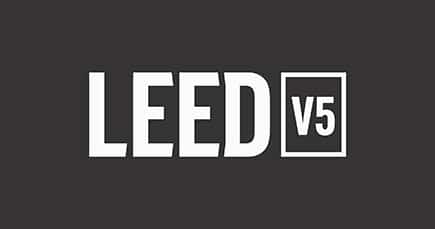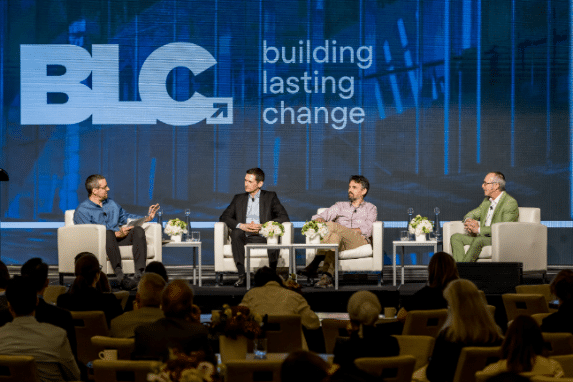What new prerequisites under LEED v5 mean for projects
New mandatory requirements raise the bar for certification
CAGBC staff on June 3, 2025
- Theme
- Certification updates
With the release of LEED v5, new prerequisites have been introduced across the major rating systems, BD+C, ID+C, and O+M; these mandatory requirements set a higher standard for building design and operations. Similar to the optional credits, these prerequisites are aligned with LEED v5’s three key impact areas: decarbonization, quality of life, and ecological conservation and restoration.
Below is an overview of the new prerequisites for LEED v5 BD+C: New Construction across the three key impact areas to help project teams understand, prepare for, and align their strategies with the updated requirements of LEED v5.


Decarbonization
Carbon assessment: Through LEED Online, data will be assembled from other prerequisites to provide a 25-year projection of the project’s emissions from operations, refrigerants, and embodied carbon. (Also included in ID+C).
Minimum water efficiency: The new prerequisite combines two previous ones from LEED v4 for Indoor Water Use Reduction and Outdoor Water Use Reduction. (Also included in ID+C).
Operational carbon projection and decarbonization plan: All project teams are now required to do a design analysis to consider efficiency, peak load reduction, and decarbonization measures during the early stages of the design. Additionally, project teams will be required to estimate the amount of each type of energy the project will use annually in terms of site energy and this will support the Carbon Assessment prerequisite in a 25-year carbon assessment which the building owner must review. Project teams will also be required to create a plan detailing how decarbonization could be achieved through a 25-year period; however, projects earning 4-5 points under the Electrification credit are exempt from this latter requirement. (A similar prerequisite is available for O+M and ID+C.)
Quantify and assess embodied carbon: This new prerequisite requires the quantification of the embodied carbon impacts (global warming potential or GWP) of the structure, enclosure, and hardscape materials for the project. At a minimum, the analysis must include all asphalt, concrete, masonry, structural, steel, insulation, aluminum extrusions, structural wood and composites, cladding, and glass. Project teams can either quantify the cradle-to-gate (A1–A3) embodied carbon emissions for each material, calculated through the amount of material used, or use the A1-A3 results from a whole building Life Cycle Assessment (wbLCA). Additionally, project teams will need to identify the top three sources of embodied carbon on the project and describe how project-specific strategies were considered to reduce the impacts of these hot spots. (A version of this prerequisite is also within ID+C.)
Quality of life
Climate resilience assessment: Requires project teams to complete a climate and natural hazard assessment to identify observed, projected, and future natural hazards that could potentially affect the project’s site and building function, as well as address site-specific natural hazards. (Also included in ID+C and +M).
Human impact assessment: A human impact assessment must be completed that draws on relevant information from demographics, local infrastructure and land use, human use and health impacts, and occupant experience. (Also included in ID+C and O+M).
Construction management: The requirements within this prerequisite were previously under LEED v4 Construction Indoor Air Quality Management Plan. With over 95 per cent achievement rate of this prerequisite (97 per cent in Canada), the previous LEED v4 credit has now become a prerequisite. One critically important new addition; implementing measures that protect construction workers from extreme heat. (A similar prerequisite is available for ID+C.)
Fundamental air quality: This prerequisite incorporates LEED v4’s required Minimum Indoor Air Quality Performance. The standard utilized has been updated to ASHRAE Standard 62.1-2022. Additionally, elements of LEED v4’s credit Enhanced Indoor Air Quality Strategies are now required, such as entryway systems, though there is no set length requirement. Additionally, all dwelling units are required to have carbon monoxide (CO) monitors on each floor of each unit, hardwired with battery backup, regardless of the type of equipment installed. (A similar prerequisite is available for ID+C.)
No smoking or vehicle idling: While this is a familiar prerequisite to LEED users, a new requirement prohibits vehicle idling on-site. A new exception requested by CAGBC, is now provided: this prerequisite is not intended to prohibit or deter indigenous or other cultural ceremonial practices (e.g., smudging) which may include the combustion of tobacco and other ceremonial materials. LEED projects that accommodate cultural ceremonial practices may still pursue this prerequisite. (A similar prerequisite is available for O+M and ID+C.)
Ecosystem conservation and restoration
Minimize site disturbance: The requirements incorporate measures from LEED v4’s prerequisite Construction Activity Pollution Prevention, along with attributes from the previous credit Site Assessment. Included alongside this are added requirements for conserving special-status vegetation and addressing removal of invasive species during construction.
Minimum Water Efficiency: This prerequisite serves the goals of both Decarbonization (as noted above) and Ecosystem Conservation and Restoration.
No Smoking or Vehicle Idling: This prerequisite serves the goals of both Quality of Life (as noted above) and Ecosystem Conservation and Restoration.
For detailed guidance on each prerequisite and to learn more about alternative compliance paths, project-specific applications, and adjustments for rating systems such as Core and Shell, consult CAGBC’s LEED Resources.
Hear more about new changes under LEED v5 at Building Lasting Change
In LEED v5: Let’s get technical, a session at Building Lasting Change™ (BLC) conference, taking place June 18–20 in Vancouver, BC., Canadian subject matter experts and CAGBC Technical staff will dig into the new requirements for Building Design + Construction (BD+C), and highlight the most important updates to credits and the rationale behind specific changes.
Register for BLC before price increases on June 5, 2025.
